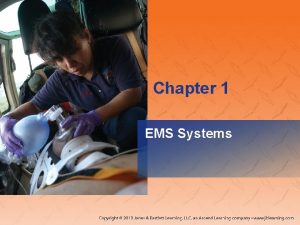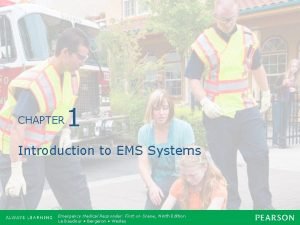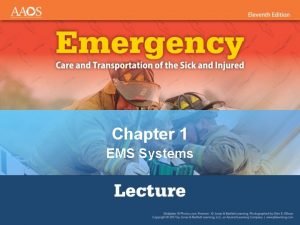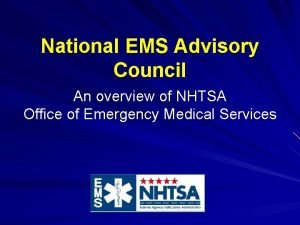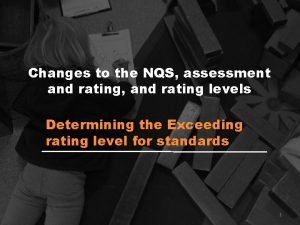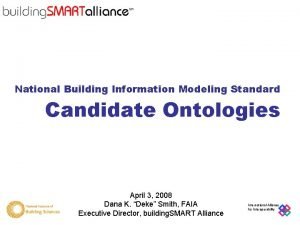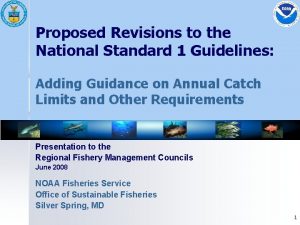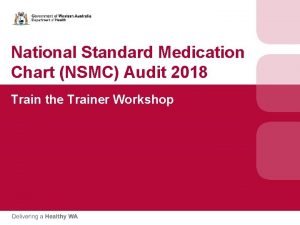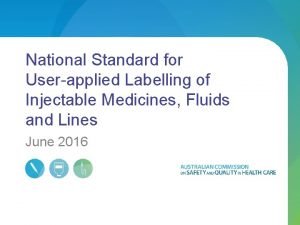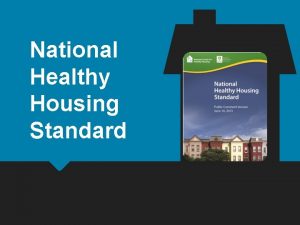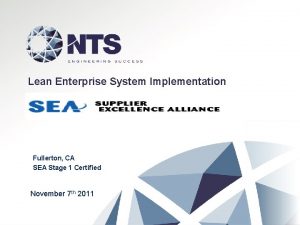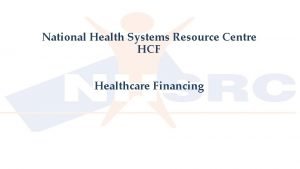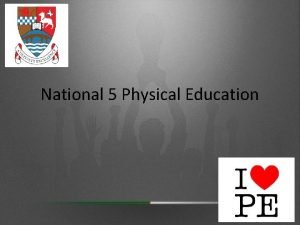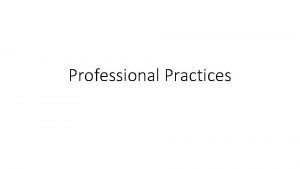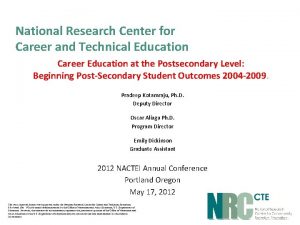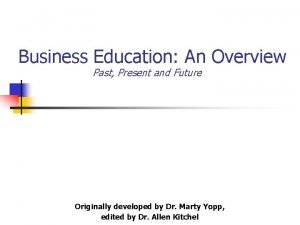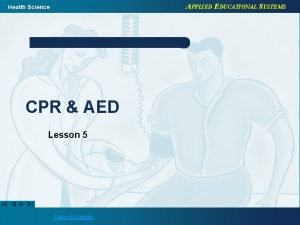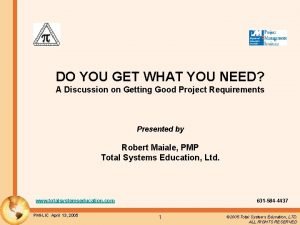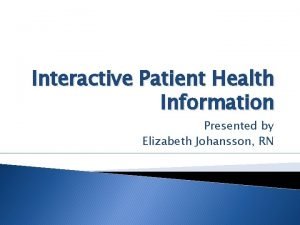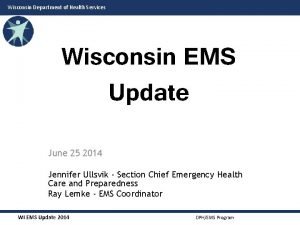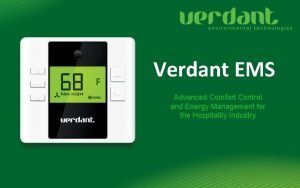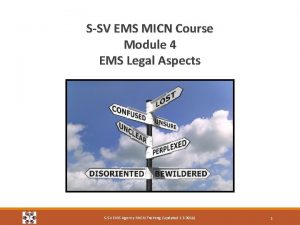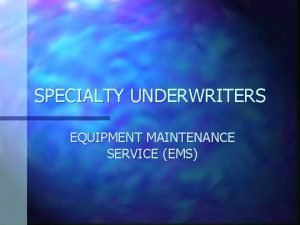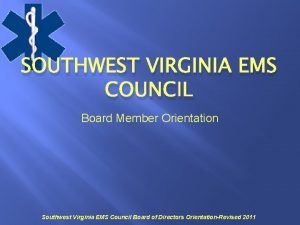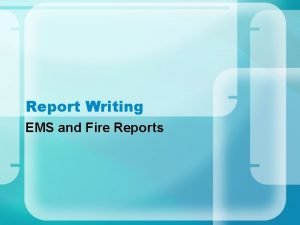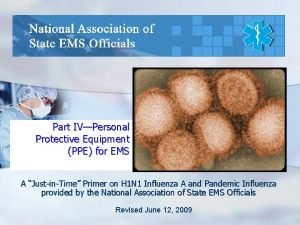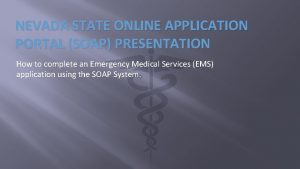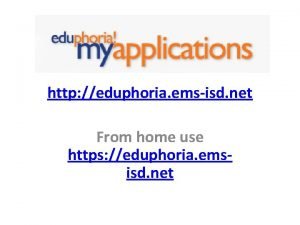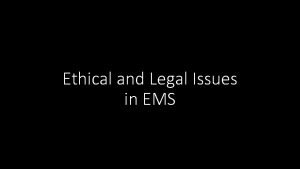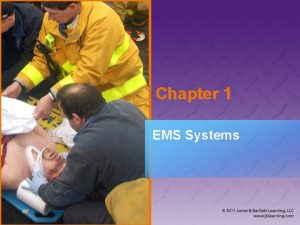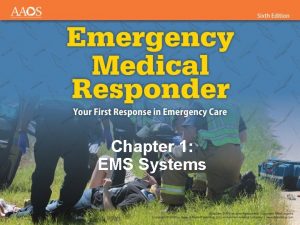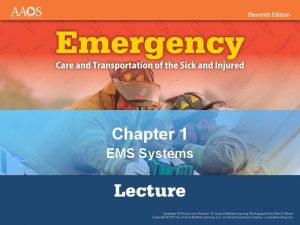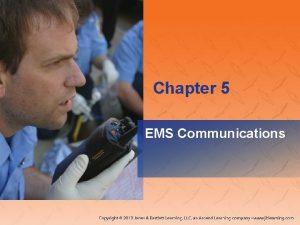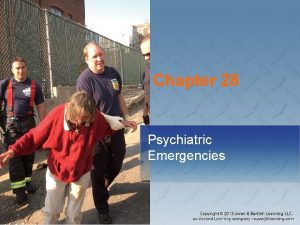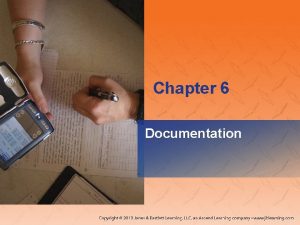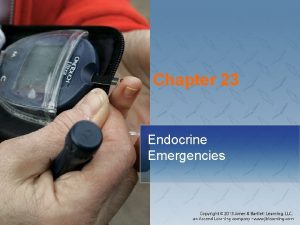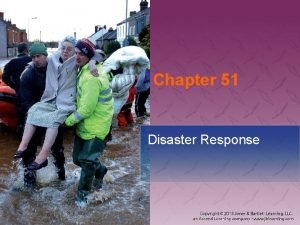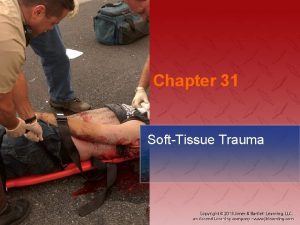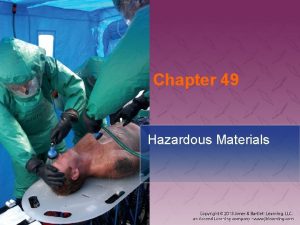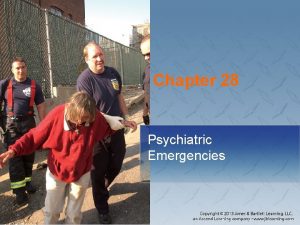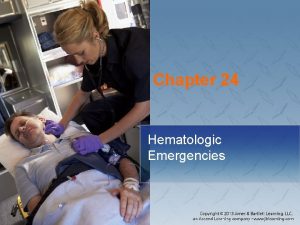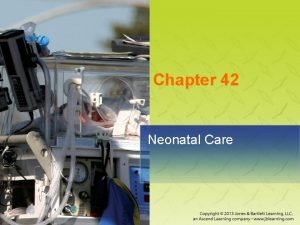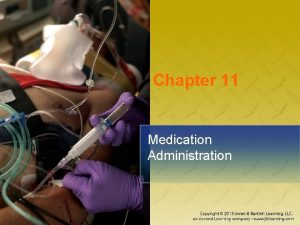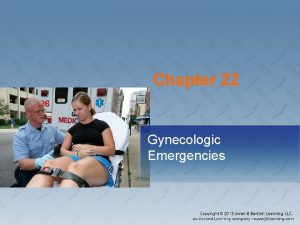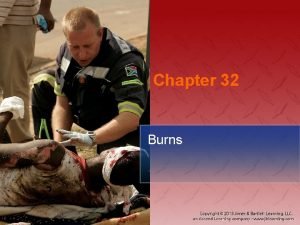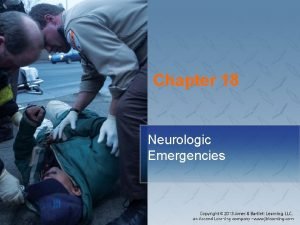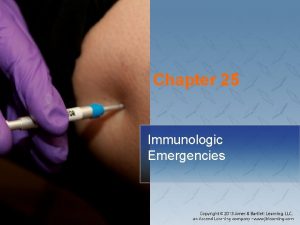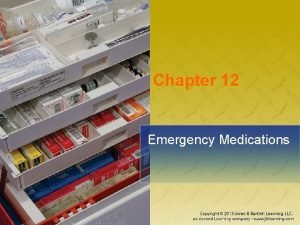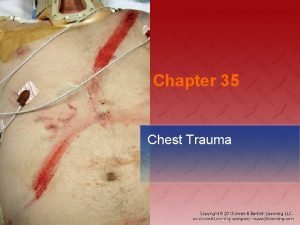Chapter 1 EMS Systems National EMS Education Standard















































































- Slides: 79

Chapter 1 EMS Systems

National EMS Education Standard Competencies Preparatory Integrates comprehensive knowledge of the EMS system, safety/well-being of the paramedic, and medical/legal and ethical issues, which is intended to improve the health of EMS personnel, patients, and the community.

National EMS Education Standard Competencies Emergency Medical Services (EMS) Systems – EMS systems – History of EMS – Roles/responsibilities/professionalism of EMS personnel – Quality improvement – Patient safety

National EMS Education Standard Competencies Research – Impact of research on emergency medical responder (EMR) care – Data collection – Evidence-based decision making – Research principles to interpret literature and advocate evidence-based practice

Introduction • The EMS system is constantly evolving. – Originally, the primary role was transportation. • As a paramedic, you will encounter many different situations. © Mark C. Ide

Introduction • The public’s perception of you is based on: – TV and articles – Your treatment of their loved ones • Continued education is a must. • Treat everyone with respect and dignity.

The History of EMS • 1485 – First use of an ambulance – Transport only • 1800 s – First use of ambulance/ attendant to care for injuries on site • 1926 – Service started similar to present day • 1940 s – EMS turned over to fire and police departments – No standards set

© National Library of Medicine The 20 th Century and Modern Technology • EMS made major strides after WWII. – Bringing hospital to field gave patients a better chance for survival – Korean War • First use of a helicopter • M*A*S*H units

The 20 th Century and Modern Technology • 1956 – Mouth-to-mouth resuscitation developed • Late 1950 s/early 1960 s – Focus shifted to bringing hospital to patients – MICUs developed

The 20 th Century and Modern Technology • 1965: “The White Paper” released – Findings included: • Lack of uniform laws and standards • Poor-quality equipment • Lack of communication • Lack of training

The 20 th Century and Modern Technology • “The White Paper” findings outlined 10 critical points for EMS system – Led to National Highway Safety Act – Created US Department of Transportation • 1968 – Training standards implemented – 9 -1 -1 created

The 20 th Century and Modern Technology • 1969 – First true paramedic program – Standards for ambulance design and equipment • 1970 s – NREMT began Courtesy of Eugene L. Nagel and the Miami Fire Department

The 20 th Century and Modern Technology • 1970 s (cont’d) – 1971: Emergency Care and Transportation of the Sick and Injured published by the AAOS – 1973: Emergency Medical Services System Act – 1977: First National Standard Curriculum for Paramedics developed by US DOT

The 20 th Century and Modern Technology • 1980 s/1990 s – Number of trained personnel grew – NHTSA developed 10 system elements to help sustain EMS system – Responsibility for EMS transferred to the states – Major legislative initiatives

Licensure, Certification, and Registration • Certification examination: – Ensures all health care providers have the same basic level of knowledge and skill – Once you pass certification you can apply for state licensure.

Licensure, Certification, and Registration • Licensure: – How states control who practices – Also known as certification or credentialing – Unlawful to practice without licensure • Holding a license shows you: – Completed initial education – Met the requirements to achieve the license • Paramedics are required to receive medical direction.

Licensure, Certification, and Registration • You may be required to be registered and licensed. – Board of registration holds your: • Education records • State or local licensure • Recertification

Licensure, Certification, and Registration • Reciprocity – Certification granted from another state/agency – Requirements: • Hold a current state certification. • Be in good standing. • National Registry certification.

The EMS System • A complex network of coordinated services that provides care to the community • The public needs to be taught how to: • Recognize emergencies. • Activate the EMS system. • Provide basic care.

The EMS System • Patient outcomes determined by: – Bystander care – Transportation – Dispatch – Response – Emergency department care – Prehospital care – Definitive care – Rehabilitation

The EMS System • Dispatchers – Usually the public’s first contact – Training level varies by state • Scene may differ from what dispatcher relays

The EMS System • As a paramedic, you must: – Develop care plan – Decide on transport method – Determine receiving facility – Be active in your community.

Levels of Education • EMS system functions from a federal to local level – Federal: National EMS Scope of Practice Model – State: Licensure – Local: Medical director decides day-to-day limits

Levels of Education • The national guidelines designed to create more consistent delivery of EMS nationally – Medical director can only limit scope of practice • 2009: National EMS Education Standards – NREMT provides a national standard for testing and certification

The Dispatcher © Peter Casolino/Alamy Images • Plays a critical role – Receives and enters information – Interprets it – Relays it to appropriate service • Some locations train EMDs – Give prearrival instructions

Emergency Medical Responder (EMR) • Formerly “first responder” • Requirements vary by state • Should be able to: – Recognize seriousness of condition. – Provide basic care. – Relay information. © Matt Dunham/AP Photosages

EMT © Amanda Herron, The Jackson Sun/AP Photos • Formerly EMT-B • Primary provider level in many EMS systems • EMT certification precedes paramedic education • Most populous level in the system

Advanced EMT (AEMT) • Formerly EMT-I • Initially developed in 1985 – Major revision in 1999 • Trained in: • More advanced pathophysiology • Some advanced procedures

Paramedic • Highest level to be nationally certified – 1999: Major revisions to curriculum greatly increased level of training and skills • Even if independently licensed, you must: – Function under guidance of physicians. – Be affiliated with a paramedic-level service.

Paramedic Education • Initial education – Most states base education programs on the National EMS Education Standards. • Outline minimum knowledge needed for practice – States require varying hours of education. • National average: 1, 000 -1, 500 hours

Paramedic Education • Continuing education – Most states require proof of hours. – Attend conferences and seminars. – Read EMS journals. – Get everyone involved in postrun critiques. • The responsibility for continuing education rests with you.

Additional Types of Transports • Specialty center – Require in-house staffs of specialists – Transport time can be slightly longer. – Know: • Location of centers • Protocol for direct transport • Interfacility – Use for: • Nonambulatory patients • Patients who require medical monitoring – Other medical professionals may accompany patient.

Working With Other Professionals • Hospital staff – Become familiar with the hospital. – You may consult with staff by using the radio through established procedures. – The best patient care occurs when emergency care providers have close rapport.

Working With Other Professionals • Public safety agents – Some have EMS training • Can better perform certain functions than you © Mark C. Ide – Interagency cooperation benefits patient

Working With Other Professionals • Continuity of care – The community has expectations of EMS – Focus on prevention – You will interact with many professional groups • Understand your role, as well as theirs.

National EMS Group Involvement • Many national and state organizations exist and invite paramedic membership. – Impact EMS future – Provide access to resources – Promote uniformity

Professionalism • You have responsibilities as a health care professional. • You will be measured by: – Standards, competencies, and education requirements – Performance parameters – Code of ethics

Professionalism • You are in a highly visible role in your community. • You must: – Instill confidence. – Establish and maintain credibility. – Show concern for your patients.

Professionalism • Your appearance is of utmost importance. – Has more impact than you may think • Present a professional image and treat colleagues with respect. – Arguing with colleagues is inappropriate. – Raise issues at the appropriate time and place.

Professionalism • Attributes of professionalism: – Integrity – Empathy – Self-motivation • Have an internal drive for excellence – Confidence • Strive to be the best paramedic you can. – Communications • Express and exchange ideas, thoughts, findings • Listen well. • Documentation is important.

Professionalism • Attributes of professionalism (cont’d): – Teamwork and respect • Work together – Patient advocacy • Act in the patient’s best interest – Injury prevention – Careful delivery of service • Deliver the highestquality care – Time management • Prioritize your patient’s needs – Administration

Professionalism • More health care locations are using paramedic services, including: – Administering vaccinations – Serving as home health nurses – Performing special transports

© Dan Myers Roles and Responsibilities

Roles and Responsibilities • Teach the community about prevention of injury and illness. Courtesy of Captain David Jackson, Saginaw Township Fire Department – Appropriate use of EMS – CPR training – Influenza and pandemic issues – Campaign for EMS system

Medical Direction • Paramedics carry out advanced skills – Must take direction from medical directors • Medical directors may perform many roles: – Educate and train – Recommend new personnel or equipment – Develop protocols, guidelines, and quality improvement programs

Medical Direction • Roles of the medical director (cont’d): – – Provide input for patient care Interface between EMS and other agencies Advocate for EMS Serve as “medical conscience”

Medical Direction • Medical directors also provide online and off -line medical control. • Online – Provides immediate and specific patient care resources – Allows for continuous quality improvement – Can render on-scene assistance • Offline – Allows for the development of: • Protocols or guidelines • Standing orders • Procedures • Training

Improving System Quality • Continuous quality improvement (CQI) – Tool to continually evaluate care – Quality control – Process of assessing current practices, looking for ways to improve – Dynamic process

Improving System Quality • Review ambulance runs when possible. • Focus of CQI is improving care • CQI can be a peer review. – Be professional – Should be a constructive process

Improving System Quality • CQI programs help prevent problems by: – Evaluating day-today operations – Identifying possible stress points • Look for ways to eliminate human error. – Ensure adequate lighting – Limit interruptions – Store medications properly

Improving System Quality • Ways to eliminate human error (cont’d) – Be careful when handing patients off. – Three main sources of errors: • Rules-based failure • Knowledge-based failure • Skills-based failure

Improving System Quality • Ways to eliminate human error (cont’d) – – – Agencies need clear protocols. Be aware of your environment. Ask yourself “Why am I doing this? ” Use cheat sheets. Be conscientious of protocols.

EMS Research • EMS has been drawn toward evidencebased practice. – Protocols should be based on scientific findings. • Research should be performed by properly educated researchers. – More education centers now offer an EMS track.

The Research Process • Identify problem, procedure, or question. • Develop research agenda by specifying: – Questions to be answered – Methods to gather data • Stick to the research agenda.

The Research Process • Determine the research domain. – Area of research – Domains: clinical, systems, or education • Research may be performed within a research consortium.

Funding • Researchers should use an IRB when a project begins. • All research requires funding. – Any type of support is considered funding. • Researchers must: – Disclose sources of funding. – Maintain transparency of research methods.

Types of Research • Qualitative – Focuses on questions within surrounding events and concurrent processes – Often used when quantitative research does not provide answers – Majority of research • Quantitative – Based on numeric data – Three types: • Experimental – Scientific approach • Nonexperimental – Descriptive • Survey

Types of Research • Retrospective – Examines available data – May be used to: • Develop educational sessions for EMS personnel • Plan public education and prevention strategies – In large studies, data often collected from widespread databases • Techniques can be used at the local level

Types of Research • Other types of research: – – – Prospective Cohort Case study Cross-sectional design Longitudinal design Literature review

Research Methods • Identify the group(s) necessary for research. • Ways to select subjects for research: – Systematic sampling – Alternative time frame sampling – Convenience sampling • Parameters should be identified.

Research Methods • Studies can be: – Blinded • Subjects not told project specifics • Single-, double-, or triple-blinded – Unblinded • Participants advised of all aspects • Research statistics can be: – Descriptive • Observations made • No attempts made to alter event – Inferential • Hypothesis used to prove one finding

Ethical Considerations • The IRB monitors whether a study is conducted ethically and ensures: – Protection of participants – Appropriate conduct • Benefits must outweigh risks. • Conflicts of interest must be identified.

Ethical Considerations • All subjects must: – Give consent. – Know their rights will be protected. – Participate voluntarily. – Be informed of all potential risks. – Be free to withdraw at any time.

Evaluating Medical Research • When evaluating research, look for certain criteria to determine the research quality. – Know what questions to answer. • Read every part of the research. • Consider the type of journal.

Evaluating Medical Research • Peer review helps ensure quality. – Subject-matter experts review material prior to publication • Internet sites can be valid tools. • Studies must follow a structured process. • There will always be limitations.

Evidence-Based Practice • Care should focus on procedures that have proven useful in improving patient outcomes. – Evidence-based practice will have a growing role in EMS. • Stay up to date on health care advances. – Make sure you understand new research results.

Evidence-Based Practice • Level I – Highest-quality evidence – Multiple studies – Large sample size – Randomization – Uses multiple techniques – Significant positive effect outcome • Level II – Single, randomly controlled trial, or – Multiple trials with small sample sizes, or – Large, randomly controlled studies – Moderate effect on patient outcome

Evidence-Based Practice • Level III – Level IIIA: Well-designed trial without randomization – Level IIIB: Evidence from causal comparison and case or cohort studies – Level IIIC: Evidence gathered from single experiments

Evidence-Based Practice • Level IV – Lowest level – Reviews of: • Descriptive studies • Expert opinion • Uncontrolled studies

Evidence-Based Practice • Research determines the effectiveness of treatment. – Can help identify which procedures, medications, and treatments do and do not work • When following a new study, measure the results with your CQI program.

Summary • Ambulance corps were developed during World Wars I and II to transport and rapidly care for soldiers. • Helicopters were used to rapidly remove soldiers from the battlefield during the Korean and Vietnam Wars.

Summary • In 1966 the National Academy of Science and the National Research Council released “The White Paper” outlining 10 points. – The National Highway Safety Act and the US Department of Transportation were created as a result. • Paramedics must be licensed (also known as certification or credentialing) before performing any functions.

Summary • Standards for prehospital emergency care, and the people who provide it, are regulated under state law by a state office of EMS. • There are four levels of training: emergency medical responder, emergency medical technician, advanced emergency medical technician, and paramedic. • Paramedics may be involved in interfacility transports and transports to specialty centers.

Summary • Paramedics should be familiar with the roles and responsibilities of other health care providers and public safety agencies. • Continuing education programs expose paramedics to new research findings and refresh their skills and knowledge. • A physician medical director authorizes EMS providers to provide care in the field through off-line or online medical direction.

Summary • There are expected standards and a code of ethics for all paramedics. • There are many professional attributes that a paramedic is expected to have, including but not limited to integrity, empathy, teamwork, patient advocacy, and time management skills.

Summary • Some of the primary paramedic responsibilities include preparation, response, scene management, patient assessment and care, management and disposition, patient transfer and report, documentation, and return to service. • Paramedics evaluate their care through quality control and continuous quality improvement.

Summary • Research establishes a consensus of what EMS personnel should or should not do. Research may be quantitative or qualitative. • There are many ethical considerations when conducting research. Researchers must always obtain consent from subjects, inform them of the research parameters, and protect their rights and welfare.

Summary • Paramedics should know how to evaluate the quality of research, including how to recognize peer-reviewed literature and how to find quality research on the Internet. • Review medical literature as it becomes available, and stay up to date on changing guidelines.

Credits • Chapter opener: © Mark C. Ide • Backgrounds: Purple – Courtesy of Rhonda Beck; Green – Jones & Bartlett Learning; Blue – Courtesy of Rhonda Beck; Lime – © Photodisc • Unless otherwise indicated, all photographs and illustrations are under copyright of Jones & Bartlett Learning, courtesy of Maryland Institute for Emergency Medical Services Systems, or have been provided by the American Academy of Orthopaedic Surgeons. • ,
 National ems education standards
National ems education standards Introduction to ems
Introduction to ems Ems systems chapter 1
Ems systems chapter 1 National ems advisory council
National ems advisory council Std error
Std error What is a standard language
What is a standard language Standard costing definition
Standard costing definition Kurikulum sekolah menengah
Kurikulum sekolah menengah 6 priorities of the department of health
6 priorities of the department of health Nqs assessment
Nqs assessment Dsmith
Dsmith National standard 1
National standard 1 Implementing nfpa 1600 national preparedness standard
Implementing nfpa 1600 national preparedness standard National standard medication chart
National standard medication chart National standard for user applied labelling
National standard for user applied labelling National healthy housing standard
National healthy housing standard Nfpa 1600
Nfpa 1600 National standard practice manual
National standard practice manual National unification and the national state
National unification and the national state National technical systems fullerton
National technical systems fullerton Systems of national accounts
Systems of national accounts Volpe national transportation systems center
Volpe national transportation systems center National health systems resource centre
National health systems resource centre International standard classification of education
International standard classification of education Career education standards 3-18
Career education standards 3-18 National forum on education statistics
National forum on education statistics National education blueprint
National education blueprint National environmental education action plan
National environmental education action plan National education foundation nef
National education foundation nef National council for special education
National council for special education National consortium of interpreter education centers
National consortium of interpreter education centers 451 fahrenheit in celsius
451 fahrenheit in celsius Early national period education
Early national period education National forum on education statistics
National forum on education statistics Factors impacting performance national 5 pe
Factors impacting performance national 5 pe Ministry of education morocco
Ministry of education morocco National education policy 1998 to 2010 in pakistan
National education policy 1998 to 2010 in pakistan Uae vision 2021 education
Uae vision 2021 education Pacret
Pacret National computing council
National computing council National forum on education statistics
National forum on education statistics National research center for career and technical education
National research center for career and technical education National science education standards inquiry
National science education standards inquiry National higher education strategic plan
National higher education strategic plan National association of special education teachers
National association of special education teachers National forum on education statistics
National forum on education statistics Aims of kothari education commission
Aims of kothari education commission Dr charles homer lane
Dr charles homer lane Future of business education
Future of business education National forum on education statistics
National forum on education statistics National core curriculum
National core curriculum National board of education finland
National board of education finland Conclusion of rmsa
Conclusion of rmsa Brownfield ap human geography definition
Brownfield ap human geography definition Ministry of national education romania
Ministry of national education romania National council for economic education
National council for economic education Decision support systems and intelligent systems
Decision support systems and intelligent systems Engineering elegant systems: theory of systems engineering
Engineering elegant systems: theory of systems engineering Embedded systems vs cyber physical systems
Embedded systems vs cyber physical systems Engineering elegant systems: theory of systems engineering
Engineering elegant systems: theory of systems engineering What does cabd stand for in cpr
What does cabd stand for in cpr Total systems education
Total systems education X-plain patient education
X-plain patient education Difference between formal education and als
Difference between formal education and als 10 difference between health education and health promotion
10 difference between health education and health promotion Types of extension education
Types of extension education Wi ems e licensing
Wi ems e licensing Uc merced cashiering services
Uc merced cashiering services Ems felvételre kijelölt posták
Ems felvételre kijelölt posták Verdant thermostat
Verdant thermostat Ssvems
Ssvems Ems equipment repair
Ems equipment repair Northern virginia ems council
Northern virginia ems council Ems latlit
Ems latlit Fire report writing
Fire report writing Nbitrex
Nbitrex Nevada ems soap
Nevada ems soap Iso 9001 environmental management system
Iso 9001 environmental management system Ems isd eduphoria
Ems isd eduphoria Oath of geneva ems
Oath of geneva ems
